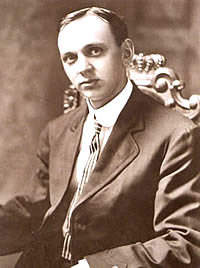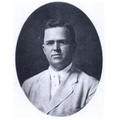Edgar Cayce facts for kids
Edgar Cayce (March 18, 1877 – January 3, 1945) was a famous American psychic. He was known as "The Sleeping Prophet" because he could talk and answer questions while in a special sleep-like state. He preferred to be seen as a healer rather than just a psychic.
Contents
How Edgar Cayce Worked
Cayce would go into a trance, which was like a deep sleep. While in this state, he could answer questions about people's health, their past, and even their future. This information was called "readings."
At first, his readings focused on people's physical health. These were called "physical readings." Later, he also gave readings about "past lives," "business advice," "dream interpretation," and even "mental or spiritual health."
Today, an organization called the Association for Research and Enlightenment (ARE) keeps all of his readings and information about what happened after them. Cayce's readings have greatly influenced New Age ideas.
Edgar Cayce's Early Life
Edgar Cayce was born on March 18, 1877, near Hopkinsville, Kentucky. From a young age, he was very religious. He started reading the Bible when he was 10 years old and wanted to help people and share his faith. His family worked on a farm.
First Jobs and Health Issues
In December 1893, his family moved to Hopkinsville. Edgar worked in a dry goods store and then a bookstore. In 1903, he married Gertrude Evans.
In 1900, Cayce started an insurance business with his father. But in March, he became very sick with laryngitis and lost his voice completely. He couldn't talk for almost a year. Because he couldn't speak, he became a photographer, which didn't require talking.
Discovering His Abilities
In 1901, a hypnotist named Hart came to Hopkinsville. He heard about Cayce's voice problem and offered to help. Hart hypnotized Cayce in front of an audience. While in a hypnotic trance, Cayce could talk clearly, but his voice would disappear again when he woke up.
Deepening His Trance Work
After Hart left, another hypnotist, Al Layne, continued to help Cayce. Layne asked Cayce, while in a trance, to explain what was causing his illness and how to cure it. Cayce, speaking as "we," said his voice loss was due to a "psychological paralysis." He explained that increasing blood flow to his voice box would fix it. Layne suggested this, and Cayce's face and chest turned red as blood rushed to the area. After 20 minutes, Cayce said the treatment was done. When he woke up, his voice was normal. He got sick again sometimes, but Layne always cured him the same way.
Growing Fame and Work
As Cayce's fame grew, so did his work. He started asking for money to support his family so he could work full-time. He continued to work in a trance state with a hypnotist throughout his life. His wife and oldest son later took over the role of guiding him during his trances. A secretary, Gladys Davis, wrote down everything he said.
In 1929, a hospital was built for Cayce in Virginia Beach, Virginia. A New York stockbroker named Morton Blumenthal paid for it.
Cayce became very famous in the United States in 1943 after an article about him appeared in Coronet magazine. He tried to do too many readings, sometimes 8 a day, which made him sick.
Challenges and Passing
The trance readings took a toll on Cayce's health. When he couldn't give a clear reading, he said it was because he was under too much pressure. In these cases, he always gave the money back to the person.
Edgar Cayce died on January 3, 1945. He had predicted his own death just four days before it happened.
He gave over 14,000 "readings" in 43 years while hypnotized. His assistant, Gladys Davis, recorded them, and his wife, Gertrude Evans Cayce, guided him.
Types of Readings
- Physical Readings: 9,603 given
These were health readings. Cayce often called the body "the organism." He would describe the client's organs, circulatory, and nervous systems. He would explain the reasons for illness and suggest ways to get better. People often came to Cayce when doctors couldn't find anything wrong or had given up.
- Life Readings: 1,920 given
In these readings, Cayce described a client's "past lives." He would explain how these past experiences might affect their current physical, emotional, and mental state.
- Business Readings: 747 given
Cayce gave business advice to people whose goals he believed were "pure." This included advice on business partners, the stock market, and how to run a business. He also helped start and guide the A.R.E..
- Dream Readings: 630 given
Edgar Cayce encouraged everyone to understand and use their own dreams. In a dream reading, Cayce would interpret a client's dreams. He believed that dreams could offer valuable insights into one's life. He also claimed that people could communicate with loved ones, remember past lives, and see possible futures through dreams. He said anyone could learn these abilities.
- Mental and Spiritual Readings: 450 given
These readings were often short and were Cayce's favorite. They focused on how a person could improve their mental and spiritual life.
- Other Readings: 954 given
These readings covered many different topics that didn't fit into the other categories. They included things like missing persons, buried treasure, psychic abilities, auras, prophecy, and geology.
What People Claimed He Could Do
People claimed Cayce had many special abilities, such as:
- Diagnosing and healing people from far away.
- Making diagnoses by leaving his body (called astral projection).
- Predicting the future.
- Talking with people who had passed away.
- Giving advice on healthy diets.
- Accessing the Akashic Records, which some believe is a record of all events, thoughts, and emotions.
- Seeing auras (energy fields around people).
Cayce himself didn't claim to be able to do all these things.
His Beliefs and Christianity
Cayce sometimes found it hard to believe what he said while hypnotized. For example, he was raised a very religious Christian, so for a long time, he couldn't believe that reincarnation was real.
Reincarnation Ideas
While in a trance, Cayce claimed that the Essenes (an ancient Jewish group) believed in reincarnation. He said this idea was removed from the Bible after a church meeting around 500 AD.
Claimed Past Lives
During a hypnosis session, Cayce said he had lived a past life as Ra Ta, an Egyptian healer-priest. He told a long story about working with a famous doctor-magician named Hermes-Thoth, who he said was later reincarnated as Jesus. Cayce also said that Jesus had lived many lives throughout history, including:
- Amilius in Atlantis
- Adam
- Enoch
- Melchizedek, a priest who blessed Abraham.
- Joseph, who was sold as a slave by his brothers.
- Joshua Son of Nun, who was Moses' helper.
- Job, a man who was tested in a famous story.
- Asaph
- Jeshua
- Zen, the father of Zoroaster, who started the religion Zoroastrianism.
Cayce's readings also warned against using religion for selfish reasons. A common saying in his readings was "God is not mocked."
Doubts and Criticisms
Skepticism About His Abilities
Many skeptics (people who question things) say that Cayce did not have special paranormal abilities. Cayce himself said that not all the information in his "readings" was correct and should be checked. He even criticized his own organization, the A.R.E [1], for not doing enough research to prove his readings were true.
Problems with the Readings
Critics also point out that the records of Cayce's readings are sometimes messy. It's hard to tell what Cayce said on his own, what information he was given in letters, and what his helpers (like doctors and hypnotists) told him. This makes it hard to say for sure that Cayce made an accurate diagnosis without knowing anything about the person. Sometimes, by the time he received a letter, the person had already passed away, but Cayce would still give a reading as if they were alive.
Vague Language
Critics also mention that Cayce's language during his trance state was often very general. For example, when he gave a reading for his own wife, who had tuberculosis, he said things like:
"[F]rom the head, pains along through the body from the second, fifth and sixth dorsals, and from the first and second lumbar ... tie-ups here, floating lesions, or lateral lesions, in the muscular and nerve fibers which supply the lower end of the lung and the diaphragm ... in conjunction with the sympathetic nerve of the solar plexus, coming in conjunction with the solar plexus at the end of the stomach....
Many of his health readings suggested cures with ingredients that didn't exist. Others were old folk remedies, some known to today's herbalists and naturopaths, but Cayce would sometimes use old-fashioned terms. Some ingredients were completely unknown to anyone. A few suggestions were even useless; for example, he once recommended breathing the fumes of apple brandy from a burned barrel to cure tuberculosis.
Legacy
Many of Edgar Cayce's readings and ideas later became common practices in the New Age movement.
In 1931, Edgar Cayce started the Association for Research and Enlightenment, Inc. (A.R.E.) in Virginia Beach, Virginia. Today, there are Edgar Cayce Centers in 18 other countries around the world.
Images for kids
-
Building (second from left) in downtown Selma, Alabama, where Cayce lived and worked from 1912 to 1923.
See also
 In Spanish: Edgar Cayce para niños
In Spanish: Edgar Cayce para niños






